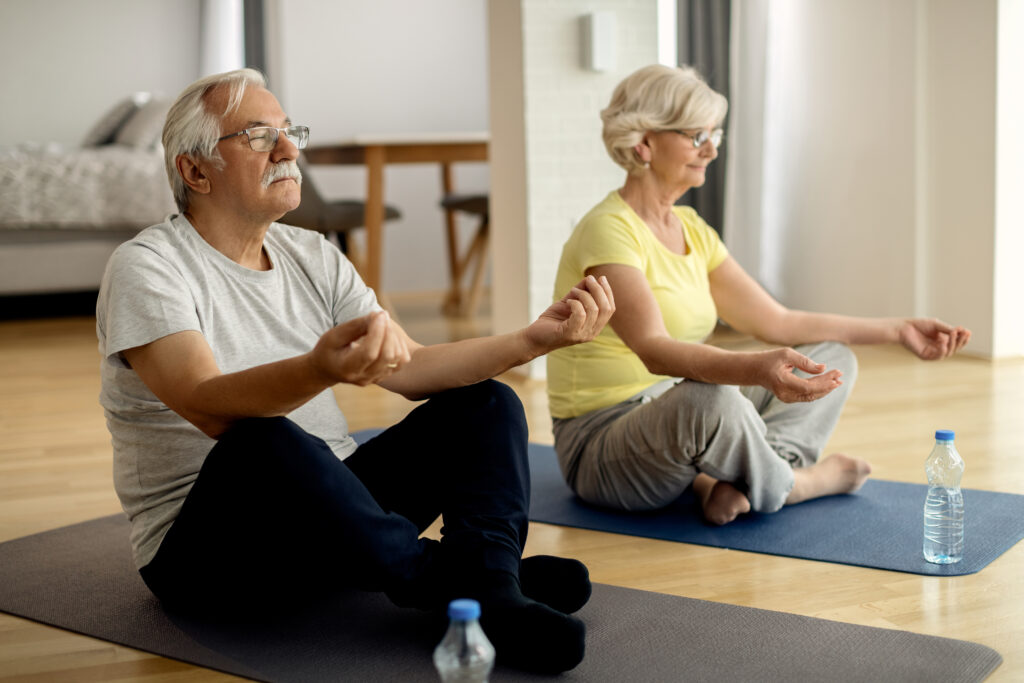
Nowadays, it may be more challenging for the elderly to maintain an active lifestyle. Well-being and physical health, however, are crucial at any age. As we get older, our bodies start to work against us, making us stiff, sore, and unable to move freely, making this a little more complicated.
The elderly might benefit from caregivers who recommend low-impact exercise activities. Yoga is one such exercise since it helps the mind and body by teaching you how to control your posture and breath.
How Can Yoga Improve an Older Adult’s Well-Being?
Physical and mental health may both benefit greatly from yoga. Incorporating a yoga practice into a senior’s daily routine may help those suffering from pain, joint tension, imbalance, osteoarthritis, and other physical restrictions.
By reducing stress hormones in the body and raising feel-good chemicals like endorphin in the brain, yoga is an effective method for alleviating anxiety and boosting mood.
The five key advantages of regular yoga practice for the elderly are as follows:
Boosted Mobility and Better Joint Health
Seniors often experience muscular and joint stiffness. Yoga is a non-aggressive practice that may significantly improve mobility and flexibility. Muscles are both stretched and strengthened by the routine.
Yoga may help stretch your muscles and ease your aching bones and joints. It is why yoga is so popular as a treatment option for patients with osteoarthritis. Yoga’s impact on older adults is beneficial compared to other forms of physical activity.
Yoga significantly improves ankle flexibility, shoulder elevation, trunk extension, and trunk flexion in healthy untrained older adults and spinal flexibility in people with chronic low back pain. Increased flexibility is not unexpected, given the static stretching nature of yoga postures.
Positive Effects on Posture and Balance
Older people have a higher risk of slipping and falling. In reality, falls are one of the leading causes of mortality among the elderly. Fortunately, regular yoga practice may help you gain strength and stability.
While it’s true that we can’t stop every fall from happening, there are plenty of ways to prevent it. In addition, if you are in relatively good physical condition, you can recover quickly.
A National Center for Biotechnology Information (NCBI) study showed that yoga drastically improved muscular strength and endurance in older adults. This study proved that yoga postures generated relatively large knee extensor joint moments of force and quadriceps activity. It confirms that older persons who regularly practice yoga increase their stability and stamina.
Stimulates Awareness and Concentration
Yoga and mindfulness seek to calm the mind to create a deeper connection and awareness of the self. Developing the ability to practice mindfulness, which involves paying close attention to one’s immediate surroundings, requires time and effort. Once you’ve mastered mindfulness, you’ll find that everything around you has a more positive vibe.
Reducing stress and practicing mindfulness may help seniors in many different life transitions, including early signs of dementia, nursing home placement, and age-related changes in routine. Mindfulness of one’s internal experiences is a critical component of a yoga practice. As a result of cultivating this kind of mindfulness practice, seniors can better keep the essential connections in their life because it helps ease anxiety, relieve depression, reduce stress, and boost their mood.
Reduces Risk of Developing High Blood Pressure
High blood pressure, also known as hypertension, is the second leading cause of kidney failure and a crucial factor in the development of heart disease. Recent research has shown that elderly persons who regularly practice yoga have lower levels of oxidative stress. Oxidative stress is a substantial risk factor for heart attacks, particularly in older adults, and it has also been related to high blood pressure.
Many seniors suffer from high blood pressure, although it is entirely avoidable with a balanced diet and routine exercise, like yoga. Paying attention to heart disease is essential since it is one of the leading causes of mortality worldwide.
Enhancement of Breathing Capacity
As you age, it’s necessary to take extra care of your lungs since breathing difficulties become more prevalent. Reduced lung function, weakened chest muscles, and a lower peak airflow are all possible outcomes of the normal aging process. Asana (posture) and pranayama (breathing) practiced in yoga have the potential to alleviate symptoms associated with these changes.
Yoga’s emphasis on controlled breathing makes it helpful in treating asthma and other breathing problems. Better breathing is one of the many health benefits adapted from yoga, especially for the elderly, as it improves posture and opens the chest muscles. The increased oxygen flow from these methods benefits the respiratory system.
The Takeaway
Yoga is a gentle exercise that can benefit people of all ages and fitness levels. These benefits are attainable without the risk of injury or discomfort, and adjusting the posture accommodates the needs of seniors with restricted mobility. Yoga effectively reduces high blood pressure, high cholesterol, tight joints, soreness, and fear of moving about or lack of confidence in one’s mobility.
Getting in shape requires effort, and the same holds for exercising. Tita Homecare’s compassionate caregivers are there to help you with these activities. We are always happy to assist and aid you, so please do not hesitate to contact us.
The photos used above are designed by Freepik